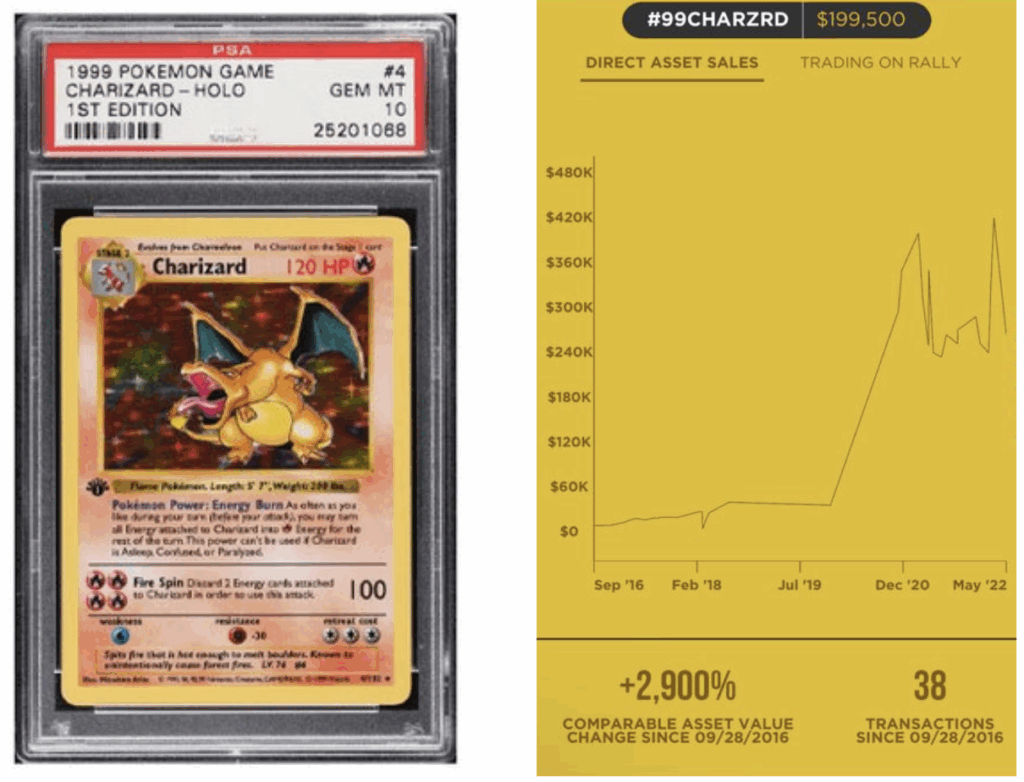Gotta Catch’Em All: Are Pokémon Trading Cards a Good Investment?
Everyone gets to pick and choose when it comes to collectibles, but investors follow the market.

How expensive is your hobby? A golfer might invest a few grand in their pastime, while a yacht racer might be able to start with a hundred grand—plus would also own a yacht. But when it comes to Pokémon cards, we don’t really associate them with such affluence. Pokémon is ingrained in the ’90s cartoon zeitgeist.
Unlike the stock market, there are no official prices in the Pokémon trading cards market so successful Pokémon card trading requires some instinct for what is valuable.
Pokémon card trading card game has skyrocketed in value and the collectibles craze of the past couple of years made its way to rare Pokémon cards—some of the most coveted ones getting sold for record-setting seven-figure prices. Many collectors are pulling their old Pokémon deck from their mom’s attic to find out what it’s worth, but common cards aren’t worth that much individually. Consider this as your crash course on Pokémon card investing.
Are Pokémon cards a good investment?
Most Pokémon cards aren’t very valuable and don’t make for great investments. But, a handful of Pokémon cards are worth a significant sum because of their scarcity. In the Pokémon trading card game, a few rare cards are coveted by collectors for attributes like being an exclusive ‘trophy card,’ being a holographic (“holo”), being a Japanese print, or other specific details.
A Pokémon card’s attributes are what make it rare and desirable to collectors, but a rare card isn’t always necessarily a good investment. What makes a rare card a good investment is being in good condition. As the supply of a rare card degrades over time, those in good condition become scarcer and are worth more to collectors. That’s why most collectors keep the rarest Pokémon cards in a protective plastic case.
How Pokémon card condition impacts value
The condition of collectible trading cards is crucial for determining if they’re potentially worth investing in, so paying to have your rare Pokémon card professionally graded could prove worthwhile. The grading scale for Pokémon cards is similar to the PSA grading system used for sports cards and the CGC system used for collectible comic books where a ’10’ grade means a card is in mint condition and a ‘1’ grade means the card is in the worst condition.

Source: comicbooknews.com
Grading Pokémon cards
Pokémon card grading is an essential part of generating profit on your investment in collectibles. A graded card usually performs better than one that hasn’t been graded, but this could also be a gamble since you don’t know if the result could help or hurt your investment. Professionally grading individual cards is only worth it if proof of their good condition will help them sell for a higher price.
Pokémon card grades
When investing in Pokémon cards, buying ones professionally graded at 10 is ideal because those are the most valuable cards. However, very rare Pokémon cards graded higher than six could also be good investments if they are scarce and desirable to collectors. Hell, even opening a Pokémon booster pack or booster box and flipping the cards inside can be profitable, but newer cards don’t perform nearly as well as high-value vintage cards do on the secondary market.
Pokémon card attributes
While it’s important to take note of all the attributes that make collectible Pokémon cards worth more, the key is finding cards with the rarest attributes. Highly coveted cards with rare attributes are extremely scarce and usually worth more money, which is why it’s best to invest in Pokémon cards from an old collection or ones that are harder to find.
Age
The Pokémon trading card game began in Japan in the late 1990s and was quickly adapted to the Anglophone market. Generally speaking, rare Pokémon cards printed in the early era—between 1996 and 2000—tend to be worth more than newer cards. While not all old cards will be worth a fortune, rare cards that are highly sought after and in good condition have recently outperformed the stock market, with the first edition Charizard being a prime example.
Aesthetic
The aesthetic features of a Pokémon card are a huge factor driving up the value of rare Pokémon cards, and the best one to point to is ‘holographic,’ which refers to a card’s glossy and near-reflective surface. Put simply, a Pokémon card being ‘holographic’ isn’t an indicator of its value but rather a feature that makes rare cards even rarer and more valuable.

Source: hypebeast.com, rallyrd.com
The best example of this is the Shadowless Holographic Charizard #4. Charizard is one of the most popular Pokémon, and the first edition Charizard is among the most coveted Pokémon cards. While most early Charizard prints are rare and can often fetch around $500, the holographic attribute combined with the shadowless frame is extremely rare (in mint condition) and can boost a Charizard card’s value well into the six figures—the last one sold for $420,000.
Rarity
If there’s one thing you should understand about investing in Pokémon cards is the concept of rarity or scarcity. Cards like the Charizard weren’t always rare but became so after the Pokémon company stopped printing them, and it gradually became harder to find older ones in good condition. However, some Pokémon cards are intentionally scarce because they were printed in a limited run.

Source: stockx.com, hypebeast.com
One example is the 1996 Japanese Base Set Holo Venusaur printed without rarity, which is usually included on the bottom right side of most Pokémon cards. Ironically, the exclusion of rarity on this print made it one of the rarest first-run Pokémon cards and it was sold for $55,000 at a PWCC auction late last year.
Limited run cards
Many valuable Pokémon cards are limited runs since these are usually the scarcest. Some of these are cards that were given as awards to winners of Pokémon tournaments, such as Kangaskhan-Holo #115, which sold for $150,000 in 2020 & 2006 Pokémon World Championships Promo No. 2 Trainer, which sold for $110,000 in 2021.

Sources: dicebreaker.com, rallyrd.com
Another example is the Blastoise Galaxy Star Hologram card that was presented to Pokemon’s Japanese executives to convince them to approve of an international release. It was a commissioned presentation by the company that created Magic the Gathering and would ultimately print the first edition of Pokémon’s English cards.
The card was never officially released, but only two have been publicly sold. One copy was sold for $360,000 in 2021, and another was listed on the collectibles investing platform Rally with a $250,000 price tag. With only two known in existence, the 1998 Blastoise test card is one of the rarest Pokémon cards ever produced. Scarcity plus historical significance gives this card a considerable value boost.

Source: dicebreaker.com
Popular Pokémon
There is a chance your booster packs will have misprints, but this could be a stroke of luck for some investors. For instance, a 2000 Pokémon Neo Genesis 1st Edition Holo Lugia #9 in perfect condition sold for over $144,000 because of its misprints, which is almost triple what it got the year before. The rareness of this card plus the popularity of Lugia in Pokémon video games makes it a hard one to catch.

Sources: dicebreaker.com, rallyrd.com
However, it isn’t always the case that the best collectible Pokémon cards are even Pokémon; the most expensive Pokémon card is actually a trainer card. The Pokémon illustrator card was awarded to winners of an art contest and is considered a Pokémon card grail worth anywhere from one to six million dollars. Another one is the 1995 Japanese Topsun Charizard Blue Back, which some argue is not part of the Pokémon trading card game despite getting auctioned for nearly half a million dollars in 2021.
How to invest in Pokemon cards
Usually, it is the seller that determines a Pokémon card’s worth, but auctions flip that around by letting the buyer choose. Investing in Pokémon cards doesn’t involve unboxing a whole booster box, but rather seeking out highly sought-after cards in good condition for the lowest price. The top auction house for buying and selling Pokémon cards is PWCC.
Unlike the stock market, there are no official prices in the Pokémon trading cards market so successful Pokémon card trading requires some instinct for what is valuable.
The downside of auctions is that they can be super competitive and someone may be willing to overpay for a particular card. This could be good for sellers, but placing your cards on auction is also a hassle. The best place to invest in a First Edition Charizard is Rally, where they have one trading for just under $200,000.
Rally is an app where you can invest in fractionalized collectibles like trading cards, sports cars, and luxury watches. That means you don’t have to pay full price to add high-end collectibles to your portfolio. You can start investing in a vintage Charizard card for just over five bucks with Rally.
